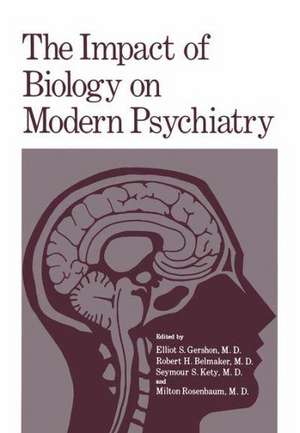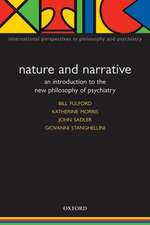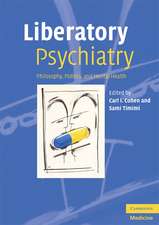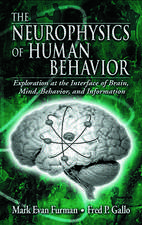The Impact of Biology on Modern Psychiatry: Proceedings of a Symposium Honoring the 80th Anniversary of the Jerusalem Mental Health Center Ezrath Nashim held in Jerusalem, Israel, December 9–10,1975
Editat de Elliot Gershonen Limba Engleză Paperback – 24 feb 2012
Preț: 372.38 lei
Preț vechi: 391.99 lei
-5% Nou
Puncte Express: 559
Preț estimativ în valută:
71.27€ • 73.45$ • 60.17£
71.27€ • 73.45$ • 60.17£
Carte tipărită la comandă
Livrare economică 01-15 martie
Preluare comenzi: 021 569.72.76
Specificații
ISBN-13: 9781468407808
ISBN-10: 1468407805
Pagini: 292
Ilustrații: XII, 276 p.
Dimensiuni: 178 x 254 x 15 mm
Greutate: 0.51 kg
Ediția:Softcover reprint of the original 1st ed. 1977
Editura: Springer Us
Colecția Springer
Locul publicării:New York, NY, United States
ISBN-10: 1468407805
Pagini: 292
Ilustrații: XII, 276 p.
Dimensiuni: 178 x 254 x 15 mm
Greutate: 0.51 kg
Ediția:Softcover reprint of the original 1st ed. 1977
Editura: Springer Us
Colecția Springer
Locul publicării:New York, NY, United States
Public țintă
ResearchDescriere
viii beginning to understand-their action, as will be brought out in this symposium. During this same period another development took place in psychiatry, namely, social and community psychiatry, interpreted by some, incorrectly, in my opinion, as the antitheses of the biological approach. The whole area of the delivery of mental health services, which quickly became more of a political and social issue than a medical one, led to confusion, disillusionment, despair, and also soul-searching by psychiatrists and other mental health professionals. The remarkable Pablo Picasso said, "the development of photography freed the artist to express his own creativity. " I have paraphrased Picasso's insightful remark, namely, "the development of biology and social and community psychiatry should free the psychiatrist to express his own creati vity as a physician. " It should allow him to regain his basic medi cal identity. As his medical identity becomes paramount, then the pejorative classification of psychiatrists into those "organically oriented" and those "dynamically-oriented" will no longer be valid. The psychiatrist, like his medical colleague, must be concerned with the psychological, psychosocial, biological, and technical aspects of psychiatry. The strengthening and development of the medical identity of the psychiatrist imposes increased responsibilities on him and on psychiatry as a medical discipline. On the one hand, he will have to become more of a neuro-bi_ gist and, on the other, more of a behavioral scientist.
Cuprins
Section I: Neurochemical Studies in Human Psychopathology.- The Significance of the Cerebral Dopamine Metabolism in the Pathogenesis and Treatment of Psychotic Disorders.- A Comparison of the Effect of Lithium and Haloperidol on Human Peripheral ?-Adrenergic Adenylate Cyclase.- Central Biochemical Correlates to Antipsychotic Drug Action in Man.- Intra/Extra Red Blood Cell Lithium and Electrolyte Distributions as Correlates of Neurotoxic Reactions During Lithium Therapy.- Pharmacologicl Agents as Tools in Psychiatric Research.- The Measurement of Biogenic Amine Turnover Using Oxygen-18.- Antibody Levels to Viruses in Psychiatric Illness.- A Tissue-Binding Factor in the Serum of Schizophrenic Patients.- Section II: Catecholamines and Behavior.- Factors Influencing The Deamination and Functional Activity of Biogenic Monoamines in the Central Nervous System.- Hypothermic Effects of Antipsychotic Phenothiazines.- Biochemical and Pharmacological Studies on an Animal Model of Hyperactivity States.- Some Old and New Theories in Biochemical Psychiatry.- Combined Use of Neuroleptic Drugs.- An Animal Model for the Measurement and Manipulation of Problem Solving Ability.- Section III: Genetic Studies in Psychiatry.- Genetic Aspects of Schizophrenia: Observations on the Biological and Adoptive Relatives of Adoptees who Became Schizophrenic.- Genetic and Biologic Studies of Affective Illness.- Genetic Studies in Schizoaffective Illness.- The Search for Genetic Polymorphisms of Human Biogenic-Amine Related Enzymes.- Twin Studies and Diagnostic Issues in Schizophrenia.- Participants.


















